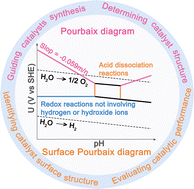Electrocatalysis is one of the cornerstones of sustainable development, offering green strategies for renewable energy storage and the conversion of valuable chemicals. Electrocatalysts, being the heart of electrocatalytic reactions, underpin the reaction activity and efficiency. However, understanding the structure and behavior of electrocatalysts remains challenging. The Pourbaix diagram is a critical tool that helps researchers evaluate the stability and behavior of materials under varying potential and pH conditions in aqueous environments. However, the Pourbaix diagram is often overlooked in the assessment of electrocatalysis, leading to discrepancies between predicted and experimental results. This gap hampers the accurate evaluation of catalyst behavior. Here, we outline the historical origin, basic principles and method for obtaining the Pourbaix diagram and applications of the Pourbaix diagram, highlighting its pivotal role in electrocatalysis.
